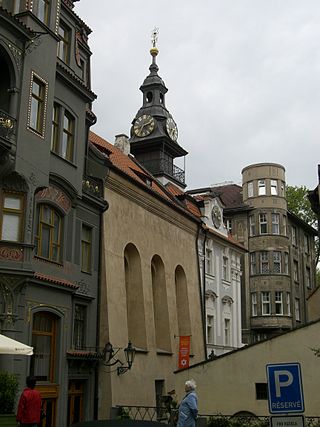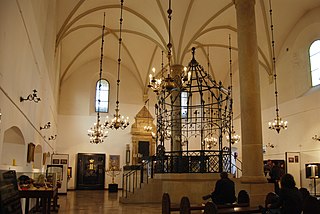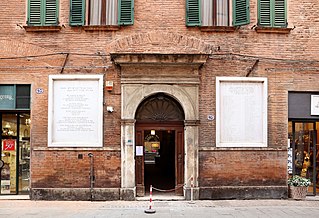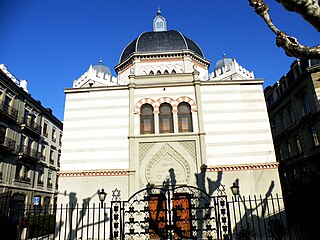
Synagogue architecture often follows styles in vogue at the place and time of construction. There is no set blueprint for synagogues and the architectural shapes and interior designs of synagogues vary greatly. According to tradition, the Shekhinah or divine presence can be found wherever there is a minyan, a quorum, of ten. A synagogue always contains an Torah ark where the Torah scrolls are kept, called the aron qodesh by Ashkenazi Jews and the hekhal by Sephardic Jews.

The Oświęcim Synagogue, also called the Auschwitz Synagogue and officially called the Chevra Lomdei Mishnayot Synagogue, is an Orthodox Jewish congregation and synagogue, located at Plac Księdza Jana Skarbka 5, Oświęcim, in the Lesser Poland Voivodeship of Poland.

The High Synagogue, also called the Josefov Vysoká Synagogue, is a Jewish congregation and synagogue, located on Červená ulice, Prague, in the Czech Republic. Used as a synagogue from 1658 until World War II, the building is now part of the Jewish Museum of Prague.

The Synagogue of El Tránsito, also known as the Synagogue of Samuel ha-Levi or Halevi, is a historic synagogue, church, and Sephardic museum in Toledo, Spain. Designed by master mason Don Meir (Mayr) Abdeil, it was built as an annex of the palace of Samuel HaLevi, treasurer to King Peter of Castile, in 1357.

The Zamość Synagogue, also the Zamość Old Synagogue or the Great Synagogue of Zamość, is a former Jewish congregation and synagogue, located in Zamość, in Lublin Voivodeship, Poland. Completed in 1618 in the Renaissance style, the synagogue is a UNESCO-protected World Heritage Site of Poland. Erected during the times of the Polish–Lithuanian Commonwealth, it functioned as a place of worship for Polish Jews until World War II, when the Nazis turned the interior into a carpenters' workshop. The structure was spared from destruction and in 1992 was listed as a World Heritage Site as part of the Old City of Zamość.

The Szydłów Synagogue is a former Orthodox Jewish congregation and synagogue, that is located at 3 Targowa Street, in Szydłów, in the Świętokrzyskie Voivodeship of Poland. The stone fortress synagogue with heavy buttresses on all sides was completed in 1564 in the Renaissance and Gothic Survival styles.

The Old Synagogue was a former Orthodox Jewish congregation and fortress synagogue, located at 24 Szeroka Street, in the Kazimierz district of Kraków, in the Lesser Poland Voivodeship of Poland.

The Kupa Synagogue, also known as the Synagogue of the Poor, is a former Jewish congregation and synagogue, that is located at 8 Warszauera Street, in the historic Kazimierz district of Kraków, in the Lesser Poland Voivodeship of Poland. The 17th-century former synagogue is located in a neighborhood earmarked in 1495 by King John I Albert for the Jewish community, that was transferred from the budding Old Town.

The Chachmei Lublin Yeshiva Synagogue is a Hasidic Jewish congregation, synagogue, and yeshiva, located at 85 Lubartowska Street, in Lublin, in the Lublin Voivodeship of Poland.

The synagogues of Kraków are a collection of monuments of Jewish sacred architecture in Poland. The seven main synagogues of the Jewish District of Kazimierz constitute the largest such complex in Europe next to Prague. These are:
- The Old Synagogue
- Wolf Popper Synagogue
- Remah Synagogue
- High Synagogue
- Izaak Synagogue
- Temple Synagogue
- Kupa Synagogue

The Włodawa Synagogue is a former Orthodox Jewish congregation and synagogue complex, located at 5-7 Czerwonego Krzyża Street, in Włodawa, in the Lublin Voivodeship of Poland. The synagogue complex comprises the Włodawa Great Synagogue, the Small Synagogue or Beit midrash, and a Jewish administrative building, all now preserved as a Jewish museum.

The Łańcut Synagogue is a former Jewish congregation and synagogue, located in Łańcut, in Podkarpackie Voivodeship, Poland. Completed in 1761, it served as a house of prayer until World War II; subsequently used for profane purposes, and as a Jewish museum since 1981. The Łańcut Synagogue is a rare surviving example of the vaulted synagogues with a bimah-tower, that were built throughout the Polish lands in masonry from the sixteenth through the early nineteenth centuries.

The Sejny Synagogue, also called the White Synagogue in Sejny, is a former Orthodox Jewish congregation and synagogue, located at 41 Piłsudskieo Street, in Sejny, in the Podlaskie Voivodeship of Poland. Designed in the Baroque Revival style and completed in 1885, the former synagogue was desecrated by Nazis during World War II and has been used as a Jewish museum and cultural center since 1987.

The Ferrara Synagogue is a Jewish congregation and synagogue complex, that is located at Via Mazzini 95, in Ferrara, in Emilia-Romagna, Italy. Designed in the Baroque style, the synagogue complex comprises the Scuola Italiana, completed in 1485 and operated until 1944; the Scuola Tedesca, completed in 1603; and the Scuola Fanese, completed in the 19th century.

The White Stork Synagogue is a Conservative Jewish congregation and synagogue, located in Wrocław, in the Lower Silesian Voivodeship of Poland. Designed by Carl Ferdinand Langhans in the Neoclassical style and completed in 1829, the synagogue is located in the city's center, which was the northern edge of the former Jewish district.

The Great Synagogue of Iași is a Jewish congregation and synagogue, located at 1 Sinagogilor Street, in Iași, in the Iași County, of Western Moldavia, Romania. The synagogue was completed in 1671 in the Baroque style, and it is the oldest surviving synagogue in Romania.

The Lendava Synagogue is a former Orthodox Jewish congregation and synagogue, located in the small town of Lendava, Slovenia, a town that is close to the Hungarian border. The former congregation was established in 1773 and worshiped in the Ashkenazi rite. The former synagogue was completed in 1866 and was used as a synagogue up until 1944, when the community perished in The Holocaust.

The Beth Yaakov Synagogue, also the Great Synagogue or the Grande Synagogue, is a Jewish congregation and synagogue, located at 11 Place de la Synagogue, Geneva, in the Canton of Geneva, Switzerland. Located in the heart of Geneva, the synagogue was completed in 1859 for the Ashkenazi Jewish community, which comprised about 200 people at the time of the synagogue's construction.

The Choral Synagogue, also called the Great Synagogue, is an Orthodox Jewish synagogue, located on Pylypa Orlyka Street, in Drohobych, Lviv Oblast in Ukraine. The congregation worships in the Ashkenazi rite.

The Synagogue of Alanta is a former Jewish congregation and synagogue, located at 3a Ukmergės Street, in Alanta, in the Molėtai District Municipality, in the Utena County of Lithuania. A wooden synagogue that was designed in the Romantic style, the building operated as a synagogue from the mid-19th century until it was devastated by Nazis in 1941. Subsequently used for profane purposes, the building was restored during 2021 and now operates as a cultural center.


































